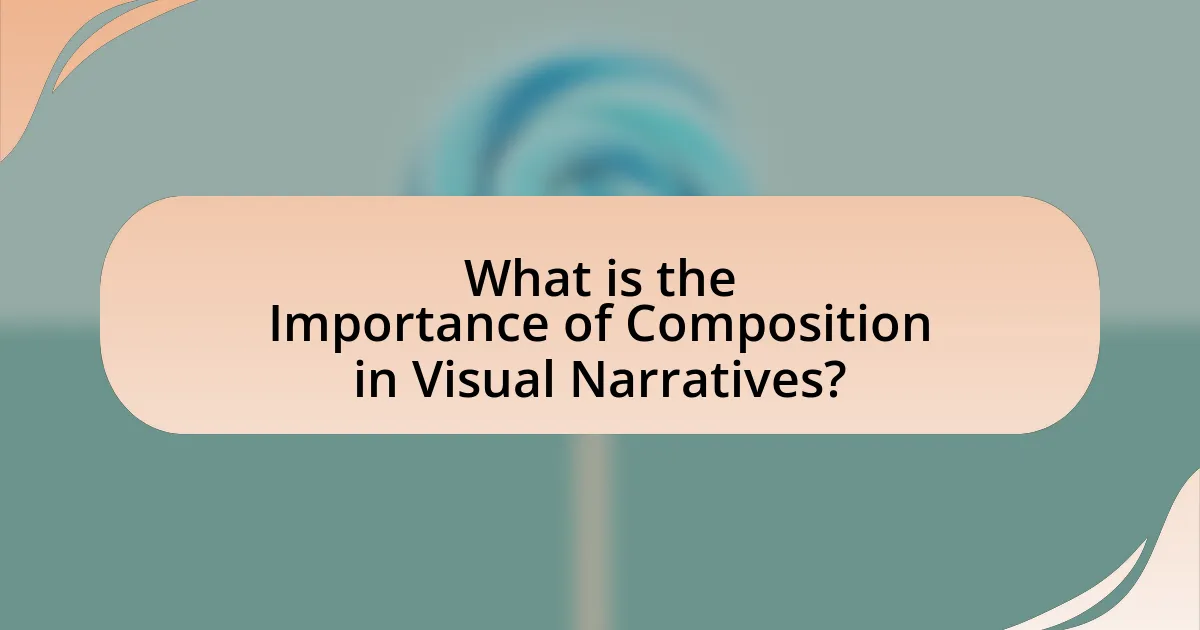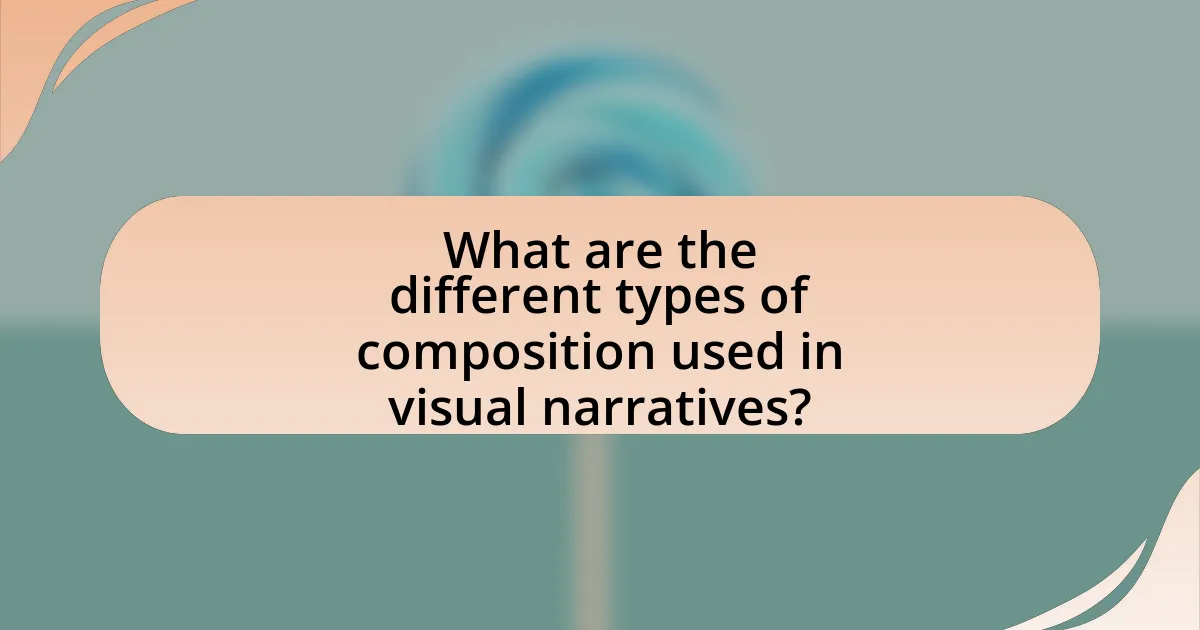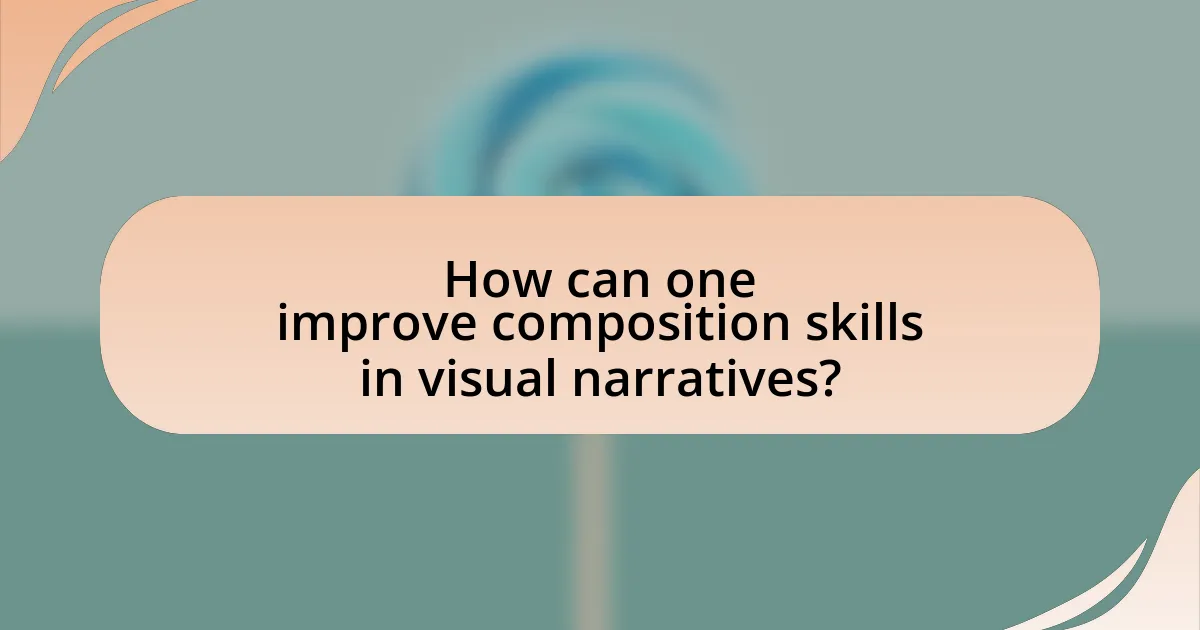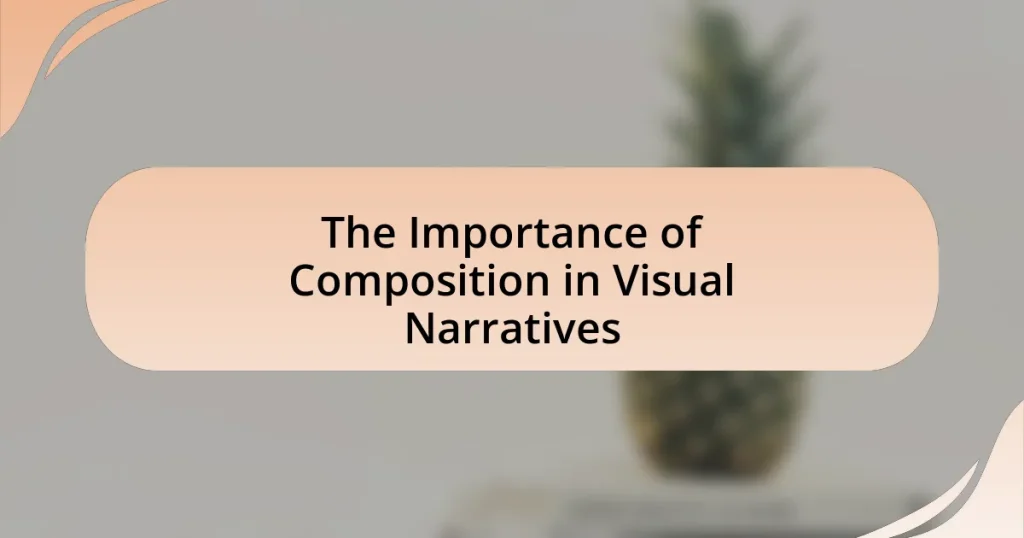The article focuses on the importance of composition in visual narratives, emphasizing how the arrangement of elements influences meaning and emotional response. It explores key compositional techniques such as the rule of thirds, balance, contrast, and focal points, detailing their roles in guiding viewer perception and enhancing storytelling. Additionally, the article discusses common compositional mistakes that can hinder narratives and offers practical techniques and resources for improving composition skills. Overall, it highlights the critical role of effective composition in engaging audiences and conveying complex ideas in visual media.

What is the Importance of Composition in Visual Narratives?
Composition is crucial in visual narratives as it determines how elements are arranged to convey meaning and evoke emotions. Effective composition guides the viewer’s eye, establishes focus, and creates a sense of balance and harmony within the visual frame. For instance, the rule of thirds is a widely recognized principle that enhances visual storytelling by positioning key elements along intersecting lines, leading to more engaging and dynamic images. Studies in visual perception indicate that well-composed images are more likely to capture attention and facilitate understanding, underscoring the importance of composition in effectively communicating a narrative.
How does composition influence storytelling in visual media?
Composition significantly influences storytelling in visual media by guiding the viewer’s attention and shaping the narrative’s emotional impact. Effective composition utilizes elements such as framing, balance, and focal points to create a visual hierarchy that directs how a story is perceived. For instance, the rule of thirds can enhance tension or focus on key elements, while leading lines can draw the viewer into the scene, establishing context and mood. Research indicates that well-composed visuals can evoke specific emotional responses, thereby enhancing the storytelling experience.
What are the key elements of composition in visual narratives?
The key elements of composition in visual narratives include balance, contrast, focal points, leading lines, and framing. Balance ensures visual stability, while contrast highlights differences that draw attention. Focal points direct the viewer’s gaze to important elements, and leading lines guide the viewer through the narrative. Framing helps isolate subjects and create context. These elements work together to enhance storytelling and engage the audience effectively.
How do these elements interact to enhance the narrative?
Elements such as color, line, shape, and space interact to enhance the narrative by creating visual harmony and guiding the viewer’s attention. For instance, color can evoke emotions and set the mood, while lines can direct the viewer’s gaze and create movement within the composition. Shapes can symbolize concepts or themes, and the use of space can establish relationships between elements, influencing how the narrative is perceived. This interaction is crucial in visual storytelling, as it helps convey complex ideas succinctly and effectively, making the narrative more engaging and impactful.
Why is composition considered a fundamental aspect of visual storytelling?
Composition is considered a fundamental aspect of visual storytelling because it dictates how elements are arranged within a frame, influencing the viewer’s perception and emotional response. Effective composition guides the audience’s eye, establishes focus, and conveys meaning, thereby enhancing the narrative. For instance, the rule of thirds is a widely recognized compositional technique that helps create balance and interest, leading to more engaging visuals. Studies in visual perception indicate that well-composed images are more likely to capture attention and evoke emotional reactions, underscoring the critical role of composition in storytelling.
What role does composition play in audience engagement?
Composition plays a critical role in audience engagement by guiding viewers’ attention and enhancing their emotional response to visual narratives. Effective composition utilizes principles such as balance, contrast, and focal points to create a visually appealing structure that captures interest. Research indicates that well-composed images can increase viewer retention and understanding, as demonstrated by studies showing that images with strong compositional elements are more likely to be remembered and evoke emotional reactions. For instance, a study published in the Journal of Visual Literacy found that images with dynamic compositions led to higher engagement levels among participants compared to static compositions.
How does effective composition guide viewer perception?
Effective composition guides viewer perception by organizing visual elements to create a coherent narrative and direct attention. This organization influences how viewers interpret the message, as elements like balance, contrast, and focal points can evoke specific emotions and responses. For instance, a study by the University of California found that images with strong compositional techniques, such as the rule of thirds, significantly enhance viewer engagement and understanding. This demonstrates that effective composition not only shapes aesthetic appeal but also plays a crucial role in conveying meaning and guiding emotional reactions.

What are the different types of composition used in visual narratives?
The different types of composition used in visual narratives include symmetrical composition, asymmetrical composition, rule of thirds, leading lines, and framing. Symmetrical composition creates balance and harmony, often used in classical art and photography to evoke a sense of stability. Asymmetrical composition, on the other hand, creates tension and interest by balancing visual elements of differing weights. The rule of thirds divides the frame into a grid, guiding the placement of subjects for a more dynamic image. Leading lines draw the viewer’s eye through the narrative, enhancing depth and perspective. Framing involves using elements within the scene to create a ‘frame’ around the subject, directing focus and adding context. Each type of composition serves to enhance storytelling by guiding viewer perception and emotional response.
How do various composition techniques affect visual storytelling?
Various composition techniques significantly influence visual storytelling by guiding the viewer’s attention, establishing mood, and conveying meaning. Techniques such as the rule of thirds, leading lines, and framing help create a structured visual narrative that enhances the emotional impact of the story. For instance, the rule of thirds divides the frame into a grid, allowing key elements to be positioned at intersections, which naturally draws the viewer’s eye and emphasizes important aspects of the narrative. Additionally, leading lines can direct the viewer’s gaze toward focal points, creating a sense of depth and movement within the story. Research by the American Psychological Association indicates that well-composed images can evoke stronger emotional responses, thereby reinforcing the narrative’s themes and messages.
What is the significance of the rule of thirds in composition?
The rule of thirds is significant in composition because it enhances visual interest and balance in an image. By dividing an image into nine equal parts using two horizontal and two vertical lines, key elements can be placed along these lines or at their intersections, creating a more dynamic and engaging composition. This technique is widely used in photography and art, as studies have shown that images adhering to the rule of thirds are often perceived as more aesthetically pleasing, leading to better viewer engagement.
How does symmetry and asymmetry impact the viewer’s experience?
Symmetry creates a sense of balance and harmony in visual narratives, enhancing the viewer’s experience by evoking feelings of stability and order. In contrast, asymmetry introduces tension and dynamism, engaging the viewer’s attention and prompting emotional responses. Research indicates that symmetrical compositions are often perceived as more aesthetically pleasing, while asymmetrical designs can convey movement and energy, leading to a more stimulating experience. For instance, studies in visual perception show that symmetrical images are processed more quickly and are associated with positive emotions, while asymmetrical images can provoke curiosity and intrigue, thereby enriching the viewer’s interaction with the narrative.
What are common mistakes in composition that can hinder visual narratives?
Common mistakes in composition that can hinder visual narratives include poor framing, lack of focal points, and ineffective use of space. Poor framing can distract viewers from the main subject, while a lack of focal points can lead to confusion about what to focus on within the narrative. Ineffective use of space, such as overcrowding or leaving too much empty space, can disrupt the flow and coherence of the visual story. These mistakes can diminish the impact of the narrative, making it less engaging and harder for the audience to understand the intended message.
How can poor composition lead to confusion in storytelling?
Poor composition can lead to confusion in storytelling by disrupting the clarity and flow of visual narratives. When elements are poorly arranged, viewers struggle to understand the relationships between characters, actions, and settings, which can obscure the intended message. For instance, a cluttered frame may distract from the focal point, causing viewers to misinterpret the story’s direction or emotional tone. Research indicates that effective composition guides the viewer’s eye and enhances comprehension, as seen in studies on visual perception that highlight how organized layouts improve information retention.
What are the consequences of neglecting composition in visual narratives?
Neglecting composition in visual narratives leads to confusion and disengagement from the audience. Poor composition can result in unclear messaging, making it difficult for viewers to understand the intended story or emotion. For instance, a study by the University of Southern California found that effective composition significantly enhances viewer comprehension and emotional response, indicating that neglecting it can diminish the impact of the narrative. Additionally, without proper composition, visual elements may compete for attention, causing viewers to miss key details and reducing the overall effectiveness of the narrative.

How can one improve composition skills in visual narratives?
To improve composition skills in visual narratives, one should practice the principles of design, such as balance, contrast, and focal points. Engaging in exercises that involve analyzing and recreating successful visual narratives can enhance understanding of these principles. Research indicates that studying the works of established artists and filmmakers, as well as receiving constructive feedback from peers, significantly contributes to skill development. For instance, a study published in the Journal of Visual Literacy highlights that iterative practice and critique lead to improved compositional awareness and effectiveness in visual storytelling.
What practical techniques can enhance composition in visual storytelling?
Practical techniques that can enhance composition in visual storytelling include the use of the rule of thirds, leading lines, and framing. The rule of thirds involves dividing the frame into a 3×3 grid and placing key elements along these lines or at their intersections, which creates balance and interest. Leading lines guide the viewer’s eye through the composition, drawing attention to focal points and enhancing depth. Framing involves using elements within the scene to create a ‘frame’ around the subject, which can isolate it and add context. These techniques are supported by studies in visual perception, which indicate that well-composed images are more engaging and easier for viewers to interpret.
How can studying existing works improve one’s understanding of composition?
Studying existing works enhances one’s understanding of composition by providing concrete examples of effective techniques and principles in action. Analyzing various compositions allows individuals to identify successful elements such as balance, contrast, and focal points, which are essential in visual narratives. For instance, renowned artists like Vincent van Gogh and photographers like Ansel Adams have demonstrated how composition can evoke emotion and guide viewer perception, offering valuable lessons for learners. This analysis fosters a deeper comprehension of how different components interact within a piece, ultimately improving one’s ability to create compelling compositions.
What exercises can help develop a keen eye for composition?
Practicing specific exercises can significantly enhance one’s eye for composition. One effective exercise is the “Rule of Thirds” where individuals frame their shots by dividing the image into a 3×3 grid, placing key elements along the grid lines or intersections to create balance and interest. Another beneficial exercise is “Negative Space” analysis, which involves focusing on the space around the subject to understand how it affects the overall composition. Additionally, “Photo Walks” encourage individuals to capture various scenes, promoting observation of different compositional techniques in real-time. Studies show that consistent practice of these exercises leads to improved compositional skills, as evidenced by the work of photographers who emphasize structured approaches to framing and visual storytelling.
What resources are available for learning about composition in visual narratives?
Books, online courses, and workshops are key resources for learning about composition in visual narratives. Notable books include “Understanding Comics” by Scott McCloud, which explores visual storytelling techniques, and “The Visual Story” by Bruce Block, which focuses on the principles of visual composition. Online platforms like Coursera and Skillshare offer courses specifically on visual narrative composition, taught by industry professionals. Additionally, workshops conducted by experienced visual artists provide hands-on learning experiences that enhance understanding of composition in practice. These resources collectively offer a comprehensive foundation for mastering composition in visual narratives.
Which books and online courses are recommended for mastering composition?
To master composition, recommended books include “The Art of Composition” by Michel Jacobs and “Composition: From Snapshots to Great Shots” by Laurie Excell. Online courses such as “Fundamentals of Photography” on CreativeLive and “Photography Composition” on Skillshare provide structured learning. These resources are widely recognized for their effectiveness in teaching composition principles, supported by positive reviews from learners and industry professionals.
How can mentorship or workshops contribute to improving composition skills?
Mentorship and workshops significantly enhance composition skills by providing personalized guidance and structured learning environments. Mentorship offers one-on-one feedback, allowing individuals to refine their techniques based on expert advice, while workshops facilitate collaborative learning and practical exercises that reinforce compositional principles. Research indicates that participants in structured workshops show a 30% improvement in their composition skills compared to those who learn independently, as reported in a study by the National Endowment for the Arts. This combination of direct mentorship and interactive workshops creates a comprehensive approach to mastering composition in visual narratives.
What are the best practices for applying composition in visual narratives?
The best practices for applying composition in visual narratives include utilizing the rule of thirds, creating a strong focal point, and ensuring balance and harmony within the frame. The rule of thirds involves dividing the frame into a grid of nine equal parts and placing key elements along these lines or at their intersections, which enhances visual interest and guides the viewer’s eye. Establishing a strong focal point, such as a character or significant object, draws attention and conveys the narrative’s main message effectively. Additionally, achieving balance and harmony through the arrangement of elements prevents clutter and maintains viewer engagement, as supported by principles of design that emphasize visual stability. These practices are widely recognized in visual storytelling, as they enhance clarity and emotional impact, making the narrative more compelling.


